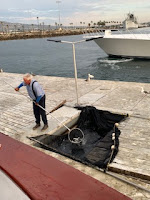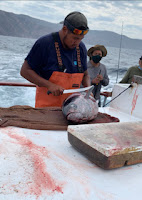Whenever I am in Los Angeles, my busy uncle Shlome, my brother, and and I try to find time to go fishing together on a party boat. Something normally goes wrong, but we always end up having a great time on the water. We woke up at 3 AM, eager to hit the water. Despite early complications with another boat, we ended up going on the Sport King out of San Pedro. It was a 3/4 day trip from 6 AM to around 5 AM. We baited up at the live bait station near the inlet of the marina, which is common at California ports, and set out. That is one of the many interesting differences between east coast and west coast fishing. The weather was nice all trip. While it was rather cooler in the morning, it got warmer as the day went on. The skies were sunny and overcast at different points in the day. While I am used to the the frequent changes in conditions being from Miami, what surprised me most was the lack of rain with the presence of the clouds. I'll take it. The weather is almost always nice in southern California.
The trip started with the long drive out to Catalina Island. This is one of the biggest differences between the fishing in Miami and SoCal; in Miami, reefs and the gulfstream are so close to the shore that fishing spots are need not be more than an hour away. Here, the drive out was over two hours. It was worth it, however. We had some great conversations on the way and, anticipating the arrival, set up the rods with just a single hook with no weight with Palomar knots. The primary fishing method on these boats is fly lining a live bait with no weight at all. The use of the Palomar knot is recommended in South California. It's a local knot, and it was funny to see and hear the reactions of the local deckhands when hearing about the uni and clinch knots often used in Miami.
We were planning to go to Catalina Island in pursuit of Yellowtail, Calico Kelp Bass, Bonito, and more, but when we got close to the island we were told that the plans had changed because the captain had heard a call about Tuna being caught nearby. Jacob was unhappy about this news because he was looking forward to dropping cut bait near the island for lots of fish to take home. Clearly he is a quantity over quality fisherman. Although Shlome and I were happy with that type of fishing, we were excited to hear about the opportunity to catch a big fish, especially one that had eluded us an a different trip before. We turned west and went towards an area with lots of boats, where we could see the Tuna being caught. The Bluefin Tuna run, which comes here during the summer, has been exceptional in recent years, much to the surprise of locals who have fished the area for years. Given the small amount of people on the boat, meaning more space, we were well equipped to catch these fish. Everyone on board had conventional reels, which was apparently better for the Tuna. The three of us, who are still learning the ropes of this type of fishing, didn't get the memo; we had spinning gear. Regardless, when we saw the first boil (the schools of Tuna busting baitfish on the surface, causing commotion and white foam to look like the water is boiling), we got set and casted out. We fly lined the live bait, hooked through the "nose" most of the time. The plan was to keep enough tension on the line to feel the baitfish swim and to let out line slowly with the bail open. We made sure to always have a lively fish on the hook, and to change it out when it starts to slow down.
Soon after the first few boils, the captain said that the fish were deeper down in the water column. We then hooked the fish in the back half, on the bottom. This way the bait would swim down, and away from the pressure. It worked. Sure enough, a Tuna took the bait and took off on a huge run. The fish put up a great fight. After tiring the fish out for a few minutes, the Palomar knot held up and the fish was gaffed and brought on board. We caught a Bluefin Tuna! It was a really cool catch. Jacob was especially happy because it was his first Tuna. The three of us were ecstatic to be on the board, and able to bring such a good eating fish home. It was a very fun fight.
We spent about the first 3 fishing hours looking for Tuna. Towards the end, before we left, Dod Shlome hooked up on a Tuna that went on a huge run before taking the hook off. It once agai8n reminded us of the power and strength of the Bluefin Tuna. The palomar knot on that rod was not very strong because it was made by one of us before we had much practice. Anyways, the boat then turned back to Catalina Island to go for some other types of fish.
The island, formed from tectonic uplift along with the other Channel Islands, was beautiful. The colors of the rocks and the water, as well as the coves, caves, and mountains on the island served as a great backdrop to the fishing and really made me appreciate being where I was. As for the fishing itself, Dod Shlome and I kept the same rigs with live bait while my brother tried a dropper loop rig at the bottom with cut squid. We spent the rest of the day at two spots on the southeast side of the island trying to catch whatever we could. The fish were biting right away. I was, again, one of those who hooked up.
The fight with the Yellowtail or Bonito, a smaller but hard fighting type of Tuna, lasted a few minutes. Much like the fight with the Bluefin, I had to play the fish and wait for the right time to reel in so that the tension wasn't strong enough to snap the line. Unfortunately, the knot ended up failing and the fish swam off to fight another day. This loss stung BAD, especially knowing that it would have been my 400th lifetime catch. It was a reminder and a lesson that you can't win them all. I will be sure to practice my palomar knot before coming back to fight these quality fish again.
Our luck changed about 20 minutes later. Jacob, who had been feeling nibbles for a while, finally hooked up on a fish. He called me over and we reeled the fish in. We caught a Calico/Kelp Bass! It was my 400th! We were all really happy about the achievement, and it's not one that I will forget. The Kelp Bass holds a special place in my heart; it was one of the first fish I ever caught, my first in Los Angeles, when I caught it with my aunt Annette on the Santa Monica Pier. After identifying the fish perfectly because of the research I had done when my interest in the sport was growing, I got the idea of starting this blog with the help of Doda Annette. I could not have been happier with the Kelp Bass being my 400th fish.
I almost hooked up one more time before we left. Another Bonito bit my bait while I left the rod resting on the bar, and it would have pulled the whole rod over if I had not picked it up in time. The bait came out very soon after, and when I reeled in the hook, I saw that the bait was chopped in half by the fish. It was never hooked. We were also hindered at the island by the many seals that would steal bait and scare off fish. Despite this, the three of us were happy with the result. We had a great time out on the water catching fish and bringing home some great dinner. We also learned a lot more about the fishing in this area. The fact that one learns something new every time they go out, whether they catch fish or not, and that it takes a lot of trial and error and learning for success are some of the things that I love most about fishing. On of the most interesting things we saw on this trip was when a fisherman near us who was fishing with lighter gear for Bass hooked up on an elusive Yellowtail. The fish took off on an unstoppable run, peeling all of the line off the reel until there was a loud snap; the fisherman was spooled and lost all the line on the reel. The Yellowtail is on my bucket list, and I one day hope to catch one of them.
Instead of the regular fish tacos, we pan seared the Tuna coated with everything bagel seasoning, which tasted great. It was an awesome way to cap off an amazing fishing trip with some really cool people. I just love fishing.





























